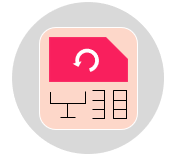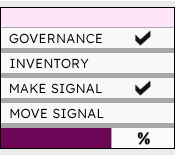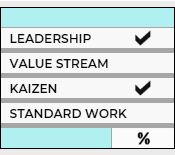
Also Known as Signal-Based Production System and Flow Control System.
Related topics include Two-Bin System, Three-Bin System, Reorder Point System, Min–Max Inventory System, FIFO.
Traditional production systems work on a push basis. Products are made according to a fixed schedule rather than real customer demand. Materials are pushed from one process to the next, even if they are not yet needed. Companies typically produce excess items “just in case”. When one process becomes unstable, it causes delays for the next, so companies often keep huge stocks to avoid stoppages. However, this creates additional costs, inefficiency, and hidden problems.
Kanban is a simple yet powerful organizational system that uses visual signals to manage the flow of materials and information. It links information flow with material flow so that nothing is produced or moved without authorization. Kanban helps to move to a pull system, because items are only produced or moved when a Kanban signal is available. The Kanban system is part of Lean production and supports Just-In-Time (JIT) production, where the right items are made in the right quantity at the right time.
Origin of Kanban
Kanban was developed by Taiichi Ohno at Toyota Motor Corporation during the 1940s and 1950s as part of the Toyota Production System. Ohno was inspired by American supermarkets during a study visit. He noticed that store shelves were restocked only after customers had purchased items and nothing was overstocked. He realized that a factory could function like a supermarket, where each process produces only what the next process withdraws. This idea became the foundation of the pull production system that aims to eliminate waste and improve efficiency. Kanban transformed Toyota’s manufacturing into one of the most efficient systems in the world.

Supermarkets operate on a natural pull principle: customers select what they want when they need it, and employees restock shelves accordingly.

The word Kanban is Japanese for card, ticket, or sign. Practically, it means any signal that triggers action. It can be compared to a traffic light that tells you when to stop, go, or wait. Kanban systems can be applied across industries, offices, and even homes, to ensure that the right materials and resources are always available. You might already use a form of Kanban in daily life, for example, when you replace an empty bottle of milk or water with a new one.
Kanban Cards
Kanban cards are the physical or digital tools that control the production process in a pull system. Each card represents authorization to make or move items based on actual demand rather than forecasts. Cards are usually attached to containers or bins that hold parts or materials. When the contents are used or emptied by the next process, the attached card is sent backward as a signal to replenish or produce more.
Kanban cards can take many forms and shapes such as paper cards, plastic tags, and metal plates. Some companies use colored cards to identify different locations, material types, or suppliers. These cards can be produced in-house at a dedicated station using tools such as a computer, printer, laminator, and cutter. Any changes in part specifications or supplier information requires updating the corresponding Kanban cards.

Click to enlarge image
Although the term Kanban literally means card, physical cards are not always required. Some Kanban systems use containers as the signal themselves, so that an empty container automatically triggers a refill order. Other Kanban systems use alternative signals to indicate the need for replenishment, such as reorder signals, Andon lights, flags, marked areas, or empty spaces.
For instance, an empty cart or pallet can act as a Kanban signal. Another example is when an area becomes empty, it indicates that a unit has been taken and prompts immediate replacement. A third example is in a fast-food restaurant, the kitchen staff knows that when seven cars are in line, they should prepare ten meals to meet expected demand. What’s important is that the signal should be clear, timely, and directly linked to actual demand.

Two-Bin System is a simple inventory management method where two bins are used for the same item. When the first bin is empty, it signals that it’s time to reorder, while the second bin continues to supply materials.
Kanban Types
There are two main types of Kanban: Production Kanban and Withdrawal Kanban. Kanban can also be categorized as internal, operating within a single facility, or external, which involves outside suppliers.
Production Kanban
A Production Kanban authorizes the production of a specific quantity of parts when demanded by a downstream process. When a customer process requires more items, the production Kanban signals the supplying process to produce the exact quantity needed to meet the demand.

Click to enlarge image
A Kanban Control Board is a visual tool used to monitor and control production in real time. It helps ensure production occurs at the right time and quantity to align with the principles of JIT.
A traffic light system can be applied as a visual control to signal when production should start and for which parts.

Withdrawal Kanban
A Withdrawal Kanban authorizes the movement of parts, materials or supplies from one location to another, typically from storage to production areas. When items are consumed, the withdrawal Kanban triggers replenishment by moving the correct quantity to where it is needed.

Click to enlarge image
A Kanban Order Board is a visual management tool used to track the status of Kanban cards through the ordering and replenishment process. It typically contains sections such as items to be ordered, items ordered (Covering both internal work orders and external purchase orders), and items received.
As Kanban cards move through these sections, the board provides a clear, real-time overview of material status and helps ensure timely replenishment.

The Two-Card System
The two-card Kanban system uses both Production and Withdrawal Kanban cards to precisely control information and material flow. Materials cannot be taken without a withdrawal Kanban card, and production cannot start without a production Kanban card.

Click to enlarge image
Kanban cards should always be visible and easy to read. Detached cards are placed on designated collection boxes or posts in production areas so that responsible personnel can collect them during regular rounds. Alternatively, the cards can be sent directly to the Kanban station and posted on boards in production areas or stores to enable responsible personnel to take necessary actions.


Kanban enhances visual management by making the flow and status of items instantly visible. In turn, visual tools strengthen Kanban by making issues immediately apparent.
Getting Started with Kanban
To get started with Kanban, it is important to remember that it is a process that must be done over time. You should expect to take several weeks or months to get your system completely operational. Since every company is different, every Kanban system must be tailored to its specific needs. Start by studying what Kanban is and how it works in your industry.

There are many tools available to support the evaluation of Kanban systems within operational environments. One of the simplest and most straightforward methods is to use this Kanban Audit Checklist.
Wrapping Up
The basic idea of Kanban is to create a pull system, where each process produces only what the next process actually needs. Materials move only when there is real demand, reducing waste, minimizing waiting time, and keeping workflow smooth. These principles allow production to flow more easily and with fewer errors in everyday processes.
Kanban empowers everyone to take responsibility for workflow. Be open to input from your operators, especially in the early stages of implementation, as this helps achieve the maximum benefits. The lasting success of Kanban comes from its simplicity: clear signals, smooth flow, continuous improvement, and the engagement of everyone involved.
References
Krajewski, L., Ritzman, L., Malhotra, M. Operation Management: Processes and Value Chains. Pearson.
Rob, M. Crown Holdings. Process Improvement Program.
Heizer, J., Render, P., & Al-Zu’bi, Z. Operations Management.
Brook, Q. Lean Six Sigma and Minitab: The Complete Toolbox Guide for Business Improvement.
Other Formats
Slides
Poster

Infographic

Related Articles
Related Templates








